An insatiable appetite for ancient and modern tongues


Name Origin. Derived from saṃskṛta, meaning 'polished', 'elaborate', 'perfect'.
Classification. Indo-European, Indo-Iranian, Old Indo-Aryan. Sanskrit is the only documented language of the Old Indo-Aryan stage.
Overview. Sanskrit is, with Hittite and Mycenaean Greek, among the oldest attested Indo-European languages. It is one of the two classical languages of ancient India (Tamil is the other) with an extensive religious and philosophical literature playing an important role in linguistic studies.
Sanskrit is noteworthy not only for the numerous sound changes that words and morphemes experience as a result of their environment but also because they are reflected in writing (sandhi). It has a complex nominal and verbal morphology preserving to a great extent that of the ancestral Indo-European language and it freely uses nominal compounds, that may consist of several words, adding to an already very large lexicon. Passive constructions are very frequent as well as participial ones, the latter tending to replace the finite verb.
Varieties. Vedic or Archaic and Classical. Vedic Sanskrit (preserved in the Vedas and Brāhmaṇas) is the most ancient form of the language; it is closely related to Avestan, the Old Iranian language of the Avesta. Classical Sanskrit begins with the magisterial grammar of Panini (c. 500-400 BCE).
Status. Extinct. Vedic Sanskrit was prevalent in the northwest of the Indian subcontinent while Classical Sanskrit spread eventually to the whole of ancient India being understood mainly by the brahmanical class and the upper echelons of the warrior class. It was also a prestige language employed in inscriptions by the elites of southeast Asia. Today, it is still used in religious ceremonies.
Oldest Documents
1380 BCE. A treaty between the Hittite and Mitanni empires, inscribed in a clay tablet, mentions the Vedic gods Mitra, Varuna, Indra and Nasatya (Aśvins).
1350 BCE. A horse training manual, written in Hittite by Kikkuli 'the Mitanni', includes numerals and several technical terms in Sanskrit.
1300-1200 BCE. Rig Veda (books 2-8) containing hundreds of hymns to the Vedic gods composed in northwest India and transmitted orally during a millennium or more.
500-400 BCE. The superb grammar of Panini which was so authoritative that became normative, freezing the evolution of Sanskrit and marking the beginning of Classical Sanskrit.
150 CE. First Sanskrit inscriptions by Rudradaman I, a king of northwestern India.
Phonology
Vowels (13). There are 13 in total, including 8 monophthongs, 3 vocalic liquids, and 2 diphthongs:
a) Monophthongs (8):

-
b)Vocalic liquids (3): ɽɪ ɽɪ: ɭə
-
c)Diphthongs (2): ai, au
The vocalic (or syllabic) liquids are a combination of a liquid consonant with a brief vowel (ɪ, ə). In spite of the consonant component, they behave like vowels from the prosodical and grammatical viewpoint. Two of them (ɽɪ:, ɭə) are infrequent, specially the last one which is limited just to one verb and its derived words.
Long vowels have double duration than their short counterparts. Vowel length is phonemic.
Consonants (33). Sanskrit has 33 consonants in total including 20 stops, 4 fricatives, 5 nasals, and 4 liquids/glides. The stops and nasals are articulated at five different places, being classified as labial, dental, retroflex, palatal and velar. The palatal stops are, in fact, affricates. Every series of stops includes voiceless and voiced consonants, unaspirated and aspirated, this four-way contrast being unique to Indo-Aryan among Indo-European languages (Proto-Indoeuropean had a three-way contrast only). The retroflex consonants of Sanskrit, articulated immediately behind the alveolar crest, are not from Indo-European origin. They are, probably, the result of Dravidian language influence.
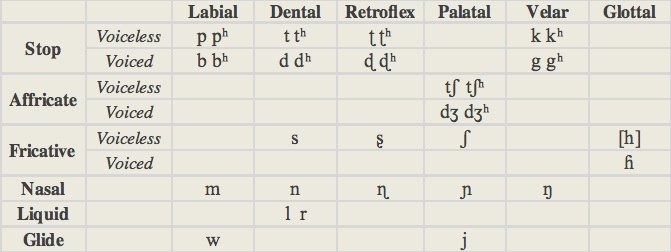
[w] is realized as [v] after vowels. The voiceless glottal fricative [h], called visarga, is restricted to word-final position and it is transliterated as ḥ.
While virtually every consonant may be at the beginning of a word, final consonants are restricted to k, ʈ, t, p, ŋ, n, m. Besides, words may end in a vowel or visarga.
Sound changes at the juncture of words and between morpheme boundaries are widespread, a process known as sandhi.
Vowel gradation (ablaut) is ubiquitous particularly in conjugation and word-derivation. Different forms of the same verb, or related words, may differ in the length or quality of a vowel. In Sanskrit, vowels are classified into three strength grades: weak, middle, strong. Comparative philology shows that the normal grade is the middle one from which vowels are weakened or strengthened, as shown in the table. Vowel gradation occurs within each column e.g. the middle grade of i is e and its strong grade is ai.

Stress. A pitch (musical) accent existed in Vedic Sanskrit but disappeared in Classical Sanskrit in which only stress accent remained. Stress falls on the penultimate syllable if it is heavy (long vowel or short vowel followed by more than one consonant). If the penultimate is light, the stress falls on the antepenultimate if it is heavy, failing which it falls on the fourth syllable from the end.
Script and Orthography. The first Sanskrit inscriptions (2nd. century CE) were written in Brāhmī, the ancestor of all South Asian scripts. Later, Sanskrit was written in a variety of scripts but from the 11th century Devanāgarī ('[the script] of the city of the gods') is of standard use. It is alphabetic but with some features of a syllabary, namely every consonant has an inherent vowel a [ɐ]. To represent other non-initial vowels, diacritic vowel signs are added before, after, above or below a consonant.
The Devanāgarī alphabet consists of 46 letters ordered according to phonetic principles (below each one the standard transliteration is shown followed by its International Phonetic Alphabet equivalent).
-
‣First come the simple vowels, then the syllabic ones followed by the diphthongs (e and o derive from ancient diphthongs and were considered so by the native grammarians). Only the characters for the initial vowels (those at the beginning of a word) are independent, being different from the internal ones (which are diacritics dependent on a consonant).
-
‣After the vowels come the stops and nasal consonants divided into five groups (each of five letters) according to their place of articulation (from back to front). Within each group the order is: voiceless unaspirated stop, voiceless aspirated stop, voiced unaspirated stop, voiced aspirated stop, nasal.
-
‣After these five groups, follow the semivowels (liquids and glides) also arranged according to their place of articulation.
-
‣Finally, the fricatives starting with the sibilants.
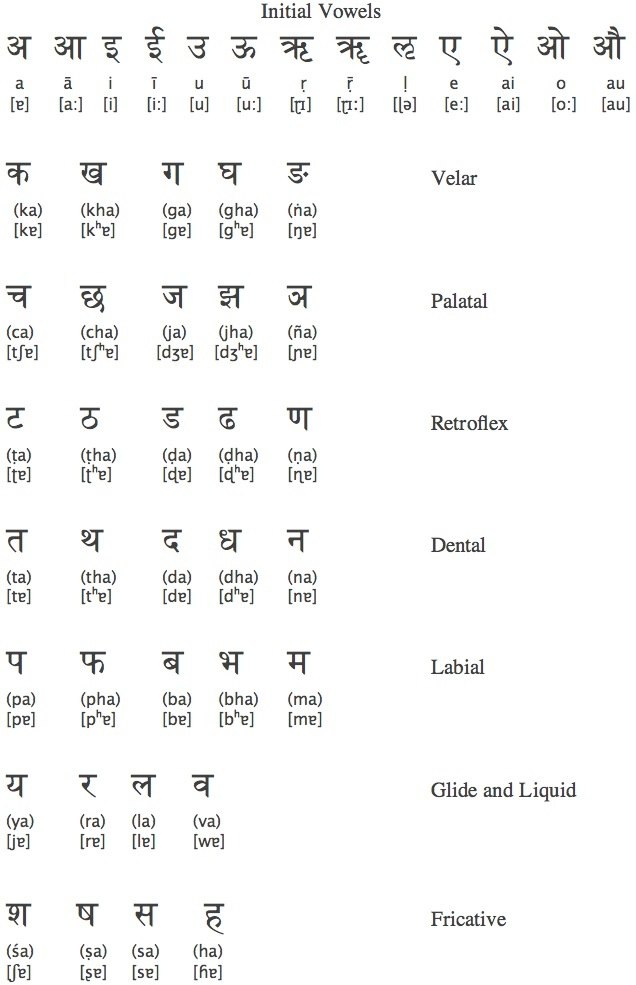
Morphology
-
Nominal. Sanskrit is an inflective language employing a variety of grammatical cases to indicate the relative function of nouns, adjectives and pronouns, a process called declension. All adjectives agree with their nouns/pronouns in case, gender, and number. There are three types of declension: nominal (nouns, adjectives), pronominal and numeral.
-
•gender: masculine, neuter, feminine. It is indicated through declension (see below).
-
•number: singular, dual, plural. The dual is obligatory when reference is made to two persons, things, or concepts. Number is indicated through declension (see below).
-
•case: nominative, vocative, accusative, instrumental, dative, ablative, genitive, locative.
-
The nominative marks the subject, the vocative is used to address somebody, the accusative marks the direct object and the object of verbs of motion ('entered the city'). The instrumental marks the instrument of an action, company ('came with the children'), and the agent in passive constructions ('the palace was built by the king'). The dative marks the indirect object or expresses purpose ('works to earn money'). The ablative indicates source ('came from the city') or cause and it also marks the second element of a comparative clause. The genitive indicates possession ('the son of the neighbor'). The locative marks location in space or time and also the object of a feeling ('compassionate to all animals').
-
Nominal declension consists in the addition of a suffix, marking case, gender and number, to an essentially invariable stem (however sandhi changes may occur at the juncture). Different paradigms exist according to the final sound and gender of the stem (there are about 30 declension paradigms).
-
The full declension of words ending in a/ā is exemplified with masculine noun kāma ('desire'), neuter noun dāna ('gift'), and feminine noun senā ('army'):
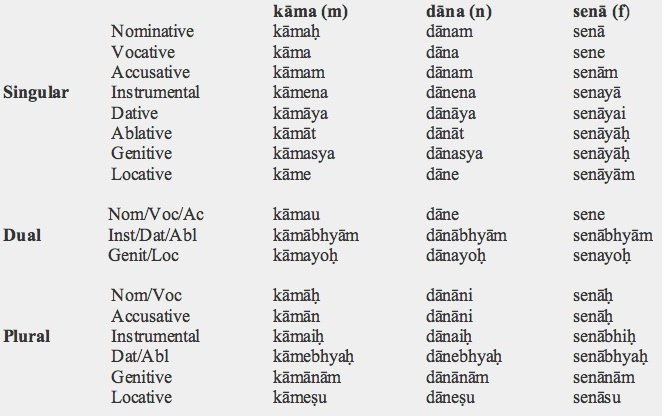
-
Declension of words ending in consonant is illustrated with masculine noun suhṛd ('friend'), feminine noun vāc ('word'), and neuter noun manas ('mind'):

-
Masculine and feminine consonant declensions are identical. Their suffixes (highlighted in red) are more representative, and more clearly discernible, than those employed in a/ā declensions. Masculine/feminine nominative and vocative singular, as well as the first three singular neuter cases, have zero suffix but the final consonant must change into a permitted one or visarga.
-
•pronouns: personal, demonstrative, interrogative, indefinite, relative, reflexive.
-
Personal pronouns are genderless and do not have a specific form for the 3rd person which is provided by demonstrative pronouns. They are inflected in all cases except the vocative. Some cases have shorter, enclitic, forms that are those most frequently used (shown below between brackets).
-
Demonstrative pronouns distinguish gender and are also fully inflected. There are five of them (three proximal and two distal). The most frequent are ayam ('this') and sa ('that').

-
In the dual, nominative and accusative are identical; instrumental, dative and ablative have also a common form, and the same happens with genitive and locative.
-
There is just one interrogative pronoun ('who?/what?') whose nominative singular is: kaḥ (masculine), kim (neuter), kā (feminine); except the nominative/accusative neuter singular (kim) it is inflected like the demonstrative sa. Indefinite pronouns and adverbs are derived from the corresponding interrogatives by adding the particles cit, cana or api.
-
The relative pronoun has the following nominative singular forms: yaḥ (masculine), yat (neuter), yā (feminine). It introduces relative clauses and, like all other pronouns, is declined in seven cases and three numbers (it follows the declension of the demonstrative sa).
-
The reflexive pronouns are ātman and svayam. The first one is declined in masculine singular for all genders, numbers and persons. The second one is invariable.
-
•articles: Sanskrit has no articles but demonstrative pronouns can function as definite articles, and indefinite pronouns as indefinite ones.
-
•compound words: Vedic Sanskrit had, like Indo-European, the capacity to form compound words, joining two, or at most three, words (usually nouns). Classic Sanskrit expanded this capacity by combining all sorts of nouns, adjectives, pronouns, adverbs, particles and verbal roots in compound words that can be very long (from 2 to 15 members or more). In a compound only the last word is declined, the others appear in their stem form.
-
There are four main compound types:
-
a)copulative, or dvandva in which two or more nouns or adjectives bear a relationship between them as it would be expressed by 'and' in English:
-
ācārya-śiṣyau
-
teacher-pupil
-
A teacher and a pupil.
-
This compound is declined in the dual number indicating that there is one teacher and one pupil. If there were more than one of them the compound would be in the plural.
-
b)descriptive or karmadhāraya in which the first element stands in an attributive relation to the second:
-
kṛṣṇa-śakuniḥ
-
black-bird
-
A black bird.
-
c)dependent or tat-puruṣa in which the head is involved in a relationship with the other members of the compound as it would be expressed by an oblique case (from accusative to locative):
-
deva-lokaḥ
-
god-world
-
The world of the gods.
-
Here, the relationship is a genitive one.
-
d)exocentric or bahu-vrīhi in which the whole compound qualifies a word outside itself:
-
aśva-mukhaḥ naraḥ
-
horse-face man
-
A horse-faced man.
-
This type of compound usually ends in a noun that behaves like an adjective agreeing in case, gender and number with the word it qualifies. In the example, even if mukha is a neuter noun it is declined as masculine to agree with naraḥ.
-
Verbal (Classical Sanskrit)
-
There are three conjugation types: primary, secondary, and periphrastic. Primary conjugations are the standard ones. Secondary, or derivative conjugations, add a particular sense to the verb. Periphrastic conjugations use auxiliary verbs.
-
Copulative verbs are frequently omitted and often the verbal function is conveyed by participles. Verbal roots are often preceded by one or more inseparable prepositions, called preverbs, that can change their meaning.
-
•person and number: 1s, 2s, 3s; 1d, 2d, 3d; 1p, 2p, 3p. The use of the dual is obligatory when the subject consists of two persons, animals or things. Gender is not distinguished except in participles.
-
•voice: Sanskrit is exceptional among Indo-European languages for having three voices, active, middle, and passive (Ancient Greek also distinguished three voices, but only in the aorist and future). The active and middle voices have their own personal endings. The passive voice is formed by adding the affix -ya- to the root plus middle personal endings.
-
In the active voice the subject of the verb is the one that performs the action (the agent). In the middle voice the subject performs the action and is, at the same time, the recipient of the action (it is the agent and the patient). In the passive voice the subject is the patient (the recipient of the action) while the agent (if it is mentioned) is usually expressed by the instrumental case.
-
Frequently, the passive voice is agentless (the agent is not mentioned because it is not relevant) or impersonal (it lacks a subject and uses always the 3rd. singular). Passive constructions with a known agent tend to rely on the past passive participle (see below).
-
•mood: indicative, optative, imperative, subjunctive (only in Vedic Sanskrit), injunctive (rare), precative (rare).
-
The optative expresses possibility, capability or (less frequently) wish. The injunctive is more common in Vedic Sanskrit than in Classical Sanskrit; in the latter it is usually restricted to express prohibition (accompanied with the negative particle mā). The precative or benedictive is used to express wishes and prayers.
-
•tense: present, future, conditional (extremely rare), and three past tenses, namely imperfect, aorist, and perfect. In spite of their names, the three past tenses do not differ in aspect and there is little or no functional difference among them. The optative and imperative moods have (in classical Sanskrit) only present tense.
-
The present has ten different conjugations, four of which are 'thematic' (they are marked by an infix ending in the thematic vowel a) and six are 'athematic' (they have no infix or have an infix ending in another vowel). In thematic conjugations the stem is the same for all persons and numbers, in the athematic ones there are vowel changes (ablaut) in the root or in the infix in the singular persons of the active voice. All classes have the same personal endings (called 'primary') with a few minor differences. Let's see the conjugation of the 10 classes in the active voice of the present indicative:
-
A) Thematic (classes 1, 4, 6, 10): bhū ('be'), nṛt ('dance'), viś ('enter'), kath ('narrate').
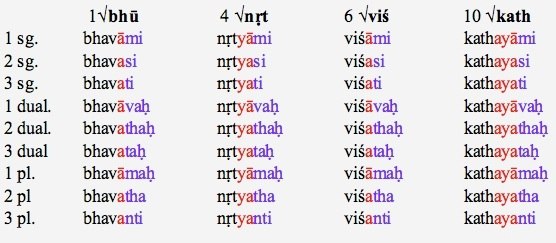
black: root
red: class infix
blue: personal endings.
The a of the infix is lengthened before m/v (in the 1st persons).
In classes 1 and 10 the root adopts the middle grade; in classes 4 and 6 the root remains in its weak grade.
B) Athematic (classes 2, 3, 5, 7, 8, 9): dviṣ ('hate'), hu ('make an offering'), su ('press out'), chid ('cut'), tan ('extend'), jñā ('know').
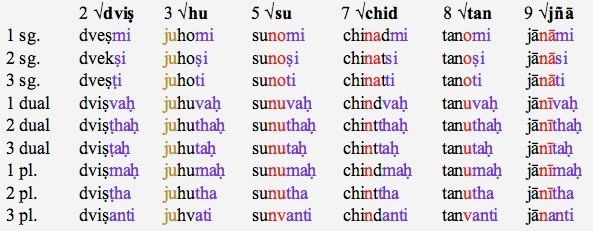
black: root
brown: reduplication of the root
red: class infix
blue: personal endings.
Classes 2 and 3 have no infix; in class 3 there is reduplication of the root (h reduplicates as j); in class 7 the infix intercalates within the root. The root in classes 2-3 and the infix in the remaining classes adopt the middle grade in the singular persons of the active voice.
-
The imperfect of the indicative, the optative and the imperative derive from the present stem. The imperfect is marked by the prefix a, the optative by the infix ī or yā, the imperative has no marker. The imperfect and the optative use 'secondary personal endings', the imperative has its own personal endings.
-
The future, the perfect and the aorist are not based on the present stem; they have their own stems, instead. The future is marked by the infix -(i)sya- and uses 'primary endings'. The aorist, like the imperfect, is marked by the prefix a and has 'secondary endings', but it has a different stem. The perfect is distinguished by reduplication of the verbal root and by having its own set of personal endings.
-
The conjugation of bhū ('be') is as follows:
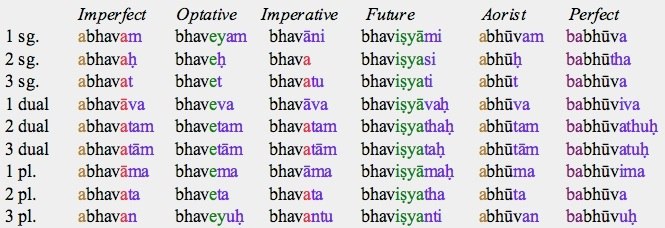
-
black: root, brown: marker of imperfect and aorist, red: class I infix
-
green: optative infix ī fused to the class marker (a + ī = e), and future infix
-
purple: reduplication, blue: personal endings.
-
•secondary (derivative) conjugations: causative, desiderative, intensive, denominative.
-
Secondary conjugations add an infix to the root (accompanied in some of them with reduplication of the root) to extend its meaning.
-
The causative, marked by the infix -aya-, conveys the idea of 'to cause to', 'to make to'. For example, the causative of the verb gam ('to go') means 'to make go', 'to lead', 'to conduct', 'to send', and that of the the verb dṛś ('to see') means 'to cause to see' i.e. 'to show'.
-
The desiderative, marked by reduplication of the root and the infix -sa-, expresses the desire to do something.
-
The intensive, marked by reduplication and the infixes -ī- or -ya-, indicates a repeated or intense action.
-
Denominative verbs, which derive from a nominal root by adding the affix -ya-, confer to a noun the notions 'to be or act like', 'to make', 'to practice'. For example, from the noun tapas ('austerities') derives the denominative tapasyati ('he practices austerities').
-
•periphrastic conjugations: periphrastic perfect, periphrastic future.
-
Periphrastic conjugations require an auxiliary verb. The periphrastic perfect is a specialized tense used as the past tense of a secondary conjugation (causative, desiderative, intensive); it is formed with one of three possible auxiliary verbs: as ('be'), bhū ('be'), or kṛ ('make'). The periphrastic future, formed with the auxiliary as, is not widely used; it should indicate a precise occurrence in the future and is usually accompanied by an adverb of time.
-
•non-finite forms: infinitive, gerund, participles.
-
The citation form of the verb (the one found in dictionaries) is not the infinitive but the verbal root. The infinitive, formed by adding the suffix -(i)tum to the root strengthened to the middle grade, is used in conjunction with verbs expressing possibility, desire or obligation. It may be also used with other verbs to express purpose as an alternative to the dative case.
-
The gerund is formed by adding the suffix -tvā to the root, or by adding -ya to it when it is preceded by a preverb. It signals than an action happened before another one and is, thus, generally followed by another verbal form (finite or non-finite).
-
Each tense and voice has a participle. All participles are declined like adjectives. There are ten participles though some are seldom used:
-
past perfect active (rare), past active, past perfect middle (very rare), past passive
-
-
present active, present middle, present passive
-
-
future active, future middle, future passive (gerundive)
-
The past passive is the most important participle. It is formed by adding -(i)ta or, sometimes, -na to the root. It frequently serves as an adjective but it can also function as a verb, most often in passive constructions though some participles can have an active meaning and replace a finite verb.
-
The past perfect active participle is infrequent in Classical Sanskrit being replaced by a new formation, the past active participle (derived from the past passive participle by adding the suffix -vat).
-
The present participles express an ongoing action or an action that is simultaneous to another.
-
The future passive participle, known as gerundive, expresses obligation or necessity.
Syntax
Word order is quite free though not totally random. There is a tendency to Subject-Object-Verb (SOV) order, though OSV is also fairly common. Genitives and adjectives usually precede their nouns. For example, in the poem Buddha Carita (2.2):
-
dhanasya ratnasya ca tasya tasya
-
wealth jewel and varied
-
blue: genitive neuter singular
-
kṛta-akṛtasya eva ca kāñcanasya
-
wrought-unwwrought and of gold
-
kṛta-akṛtasya: copulative compound
-
tadā hi na ekān sa nidhīn avāpa
-
then for not few he treasures gained
-
red: accusative masculine plural
-
brown: nominative masculine singular
-
avāpa: perfect preterite, 3rd singular (ava √āp)
-
For then, he gained not few treasures
-
of varied riches and jewels,
-
of wrought and unwrought gold.
Here, the order is subject (sa)-direct object core (nidhīn)-verb (avāpa); the adjective (na ekān) and genitive complement precede the subject.
This neutral order is, often, changed due to prosodical, rhetorical or esthetic reasons. For example in Bhagavad Gītā 2.23 it is OVS as the subject is less relevant than the fact that the soul is indestructible; besides enam is an emphatic demonstrative pronoun:
-
na enam chindanti śastrāṇi
-
not him cut swords
-
enam: accusative masculine singular
-
chindanti: present indicative, 3rd plural (√ chid)
-
śastrāṇi: nominative neuter plural
-
na enam dahati pāvakaḥ
-
not him burns fire
-
dahati: present indicative 3rd singular (√dah)
-
pāvakaḥ: nominative masculine singular
-
Swords do not cut him (the soul),
-
fire does not burn him (the soul).
Relative clauses are separate from main clauses and generally precede them, like in Bhagavad Gītā 2.19:
-
yaḥ enam vetti hantāram
-
who him believes slayer
-
yaḥ: nominative masculine singular (relative pronoun)
-
vetti: present indicative 3rd singular (√vid)
-
red colour: accusative masculine singular
-
yaḥ ca enam manyate hatam
-
who and him thinks slain
-
manyate: present indicative 3rd singular (√man)
-
ubhau tau na vijānītaḥ
-
both they two not understand
-
ubhau/tau: nominative masculine dual
-
vijānītaḥ: present indicative 3rd dual (vi √jñā)
-
Who believes him (the soul) a slayer
-
and who thinks him (the soul) slain,
-
neither of them understand.
Here, we have two relative clauses, each beginning with the relative pronoun ya, that connect with the main clause through the demonstrative pronoun sa inflected as dual (tau) to agree in number with them.
Nominal sentences (without a verb) and participial constructions are very frequent. Like in this example from the Bhagavad Gītā 4.5:
-
bahūni me vyatītāni janmāni tava ca arjuna
-
many of me passed births of you and Arjuna
-
brown: nominat. neuter plural
-
blue: genitive singular
-
green: vocative masculine singular
-
vyatītāni: past passive participle
-
Many (have been) my past births and yours, Arjuna.
There is extensive use of compound words, often including several members, like in this poem of Bhartṛhari (compounds, except copulative ones, are translated sequentially starting from the end):
-
yuṣmat-saṅga-vaśa-upajāta-sukṛta-sphāra-sphurat-nirmala-
-
you-communion-on account of-born-good action-abundant-shining-immaculate-
-
jñāna-apāsta-samasta-moha-mahimā līye para-brahmaṇi
-
knowledge-discarded-completely-illusion-power I absorb in the supreme-spirit.
-
brown: nominative masculine singular
-
grey: locative neuter singular
-
līye: present indicative 1st singular
-
(middle voice) of √lī.
I absorb (myself) in the supreme spirit, the power of illusion (having) completely discarded with immaculate knowledge shining abundantly through the good actions born on account of my communion with you.
Lexicon
The vast majority of Sanskrit words are of Indo-European pedigree. However, the language incorporated a number of Dravidian and, to a lesser proportion, Munda loans. Some Iranian and Greek loans crept into Sanskrit at a later period.
Basic Vocabulary
one: eka
two: dvi
three: tri
four: catur
five: pañca
six: ṣaṣ
seven: sapta
eight: aṣṭa
nine: nava
ten: daśa
hundred: śata
father: pitṛ
mother: mātṛ
brother: bhrātṛ
sister: svasṛ
son: sūnu
daughter: duhitṛ
head: śiras
face: mukha
eye: akṣan
hand: hasta
foot: pāda
heart: hṛd
tongue: jihvā
Key Literary Works (diacritics are not used here, except ś and ñ)
-
1300-1000 BCE Rig Veda (Knowledge of the Stanzas). Anonymous
-
A collection of more than one-thousand hymns addressed to a variety of gods of the primitive Indo-Aryan religion.
-
900 BCE Śatapatha Brahmana (Brahmana of the One Hundred Paths). Anonymous
-
An explanation of Vedic ritual, remarkable for its account of some early myths.
-
700-200 BCE Upanishads (Sitting at the feet [of the guru]). Anonymous
-
A collection of a dozen texts, some in prose, some in verse, some very long, some very short, concerned with the absolute principle called Brahman. They contain in germ many philosophical speculations.
-
400 BCE-400 CE Mahabharata (The Great [war] of the Bharata). Anonymous
-
The most extensive of the two epics of India, and one of the longest poems in the world, containing besides its narrative core a great wealth of mythological, religious, philosophical, normative, ritual, folk, and technical material.
-
100 BCE-100 CE Bhagavad Gita (The Song of the Lord). Anonymous
-
A religious poem (included in the Mahabharata) where Krishna reveals himself as the supreme god and teaches different paths to salvation, namely the path of selfless action, the path of knowledge, and the path of devotion.
-
100-200 CE Ramayana (The adventures of Rama). Anonymous
-
The other epic of India, recounting the rescue of Sita, the abducted wife of the hero Rama, with the help of an army of monkeys.
-
100-200 CE Buddha Carita (Acts of the Buddha). Aśvaghosha
-
Having as subject the life of Buddha, it is the first of the elaborate narrative poems known as mahakavya ("great poems"), more literary in style than the epics and Puranas.
-
300 CE Mric Chakatika (The Little Clay Cart). Śudraka
-
An early and long play in ten acts intertwining political and erotic intrigues to reach a climatic denouement.
-
400 CE Kumara Sambhava (The Birth of Kumara). Kalidasa
-
Perhaps the most famous of the mahakavyas, it artfully combines narrative and exquisite description to recreate the well-known myth of the birth of the war-god.
-
400 CE Megha Duta (The Messenger-Cloud). Kalidasa
-
A gracious lyric poem in which an exiled lover yearning for his distant wife prays a passing cloud to deliver a message to her describing the landmarks to be found in the trip.
-
400 CE Śakuntala. Kalidasa
-
The best drama of the three extant of Kalidasa and a masterpiece of classic Sanskrit theatre, based on a story of the Mahabharata.
-
400 CE Vishnu Purana. Anonymous
-
One of the most celebrated of the 18 Puranas ("Histories"), the major scriptures of Hinduism. It tells about the periodic creation and destruction of the universe, the genealogies of gods and sages, the reigns of the various Manus (progenitors of mankind), and the history of the legendary solar and lunar dynasties.
-
500 CE Śataka Traya (Three Hundred [poems]). Bhartrihari
-
Three collections of one hundred poems (each one of a single stanza), in a wide variety of meters, devoted to morality, love and renunciation.
-
500 CE Pañca Tantra (Five Books). Vishnu Śarman
-
A popular collection of moral stories and fables told to three ignorant princes in order to teach them the principles of good government.
-
600 CE Harsha Carita (The Acts of Harsha). Bana
-
A hyperbolical "biography" of emperor Harsha by the court poet Bana written in a brilliant, though extremely overwrought, prose.
-
700 CE Uttara Rama Carita (The Later Deeds of Rama). Bhavabhuti
-
A play based on the last book of the Ramayana where an unheroic Rama suffers the pangs of anguish and guilt for having banished his wife Sita, unjustly suspected of being unfaithful.
-
© 2013 Alejandro Gutman and Beatriz Avanzati
Further Reading
-
-The Sanskrit Language. T. Burrow. Faber & Faber (1955, reprinted by Motilal Banarsidass 2001).
-
-'Sanskrit'. G. Cardona. In Indo-Aryan Languages, 104-160. G. Cardona & DH. K. Jain (eds). Routledge (2003).
-
-'Sanskrit'. S. W. Jamison. In The Ancient Languages of Asia and the Americas, 6-32. R. D. Woodward (ed). Cambridge University Press (2008).
-
-Sanskrit: An Introduction to the Classical Language. M. Coulson. Hodder & Stoughton (1992).
-
-A Sanskrit Grammar for Students. A. A. MacDonell. Oxford University Press (1926).
-
-A Sanskrit-English Dictionary: Etymologically and Philologically Arranged with Special Reference to Cognate Indo-European Languages. M. Monier-Williams. Motilal Banarsidass (1899, reprinted 2005). Available online at: http://www.sanskrit-lexicon.uni-koeln.de/monier/webtc/index.php
-
-Héritage du Sanskrit. Dictionnaire sanskrit-français. Gérard Huet (2013). Available online at:
Sanskrit

Online Sanskrit classes via Skype or Hangouts, in English or Spanish, by one of the authors of this page and cofounder of “The Language Gulper” (Alejandro Gutman).
More info here and/or contact me by e-mail at:
MAIN LANGUAGE FAMILIES
LANGUAGE AREAS
Languages of Ethiopia & Eritrea
LANGUAGES by COUNTRY
LANGUAGE MAPS
-
• America
-
• Asia
-
Countries & Regions
-
-
Families
-
• Europe
-
• Oceania
As the Language Gulper has no advertisements it is essential that we receive some financial help, however small, in order to keep the site running and eventually expand it.
So, please, make a donation if you can.